Recent big-screen viewing
Writing about Fede Alvarez’s Alien: Romulus (202) reminds me that I haven’t actually mentioned any of the other recent movies I’ve seen in a theatre … since I go so rarely these days, I have no excuse for this neglect.
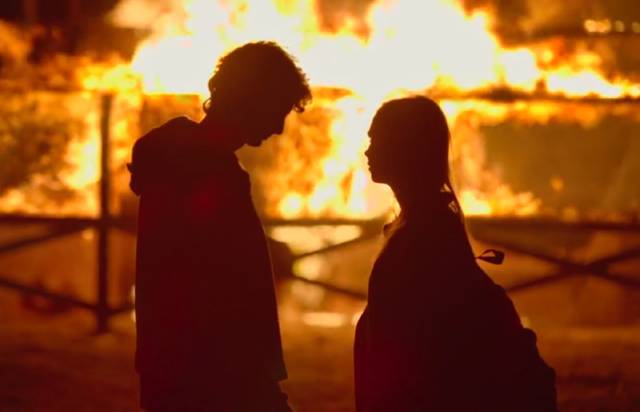
The Burning Season (Sean Garrity, 2023)
Since The Boy and the Heron back in January, I’ve seen five films on the big screen, all genre movies, though the smallest might as easily be classed as indie art. That was Sean Garrity’s The Burning Season, which I admit I went to see at least in part out of a sense of duty – I’ve known Sean since he was working on his first feature, Inertia, back in 2001, but haven’t seen all his work. After his follow-up, Lucid (2005), a bigger movie with not entirely successful fantasy/horror elements, he focused more on small, partially improvised dramas and comedies revolving around relationships and sex. The next one I saw was Blood Pressure (2012), written by another acquaintance, Bill Fugler, which played with psychological thriller tropes. The Burning Season toys with genre tropes in another relationship-centred story, but it uses a tricky reverse-narrative structure which, as I watched, alternately engaged and irritated me. In a series of chapters, each set a year earlier than the previous one, and all set at a lakeside camp, it begins with a wedding which implodes as one man gets stoned and drunk and disrupts the ceremony, and then runs backwards through the relationship between him and the bride and their intense, but problematic emotional/sexual relationship which is eventually traced to their teens and a terrible act they were both involved in, which bound them together but made a lasting relationship impossible, desire and guilt in constant conflict. I’ll eventually want to see it again to see whether Sean and writers Jonas Chernick (a frequent collaborator, on and off-screen) and Diane Frances played fair with the narrative progression, but the performances held my attention even while I was occasionally distracted by the effort of holding the story together in my head as I watched.
*
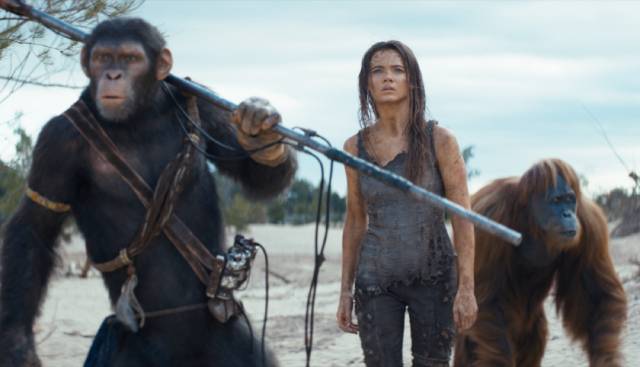
Kingdom of the Planet of the Apes (Wes Ball, 2024)
I was less satisfied, and more irritated, by Kingdom of the Planet of the Apes. I’d really liked the reboot trilogy beginning with Rupert Wyatt’s Rise of the Planet of the Apes (2011) and followed by Matt Reeves’ Dawn of the Planet of the Apes (2014) and War of the Planet of the Apes (2017), but with those three forming a very satisfying story arc, another episode seemed unnecessary (except, of course, from a commercial point of view). There’s no denying that motion-captured performances and sophisticated CGI character creation has come a very long way, so far in fact that it’s now possible to forget about the technical process as you watch the non-human characters on screen. So on that level, it’s hard to fault the movie, directed by Wes Ball, who had previously made the intermittently enjoyable Maze Runner trilogy.
Not surprisingly, this fourth film doesn’t follow directly from the trilogy, but rather refers to the previous films as distant history, with the rise of the apes now fading into myth. There are various tribes, some peaceful, some violent, and one in particular trying to unify all under a dictatorship based on Imperial Rome. The opening section follows an adolescent ape undergoing a rite of passage among the now-mysterious ruins of a human city largely reclaimed by forest. Celebrations give way to panic as a gorilla army attacks, slaughtering the adult males and enslaving the females and the young. Our teen hero evades capture and embarks on a journey to rescue what remains of his tribe.
Along the way, he encounters (all too briefly) a wise orangutan and a mute female human. The script goes back to the original Franklin J. Schaffner Planet of the Apes (1968) to recreate a number of iconic scenes – particularly a brutal attack by gorilla cavalry on a tribe of mute humans. The young hero and the human eventually make their way to the coast where the gorilla dictator is trying to break into an ancient human fortification which, legend has it, contains an arsenal of advanced weapons.
And here we get a rapid accumulation of plot absurdities which sink the movie. The mute woman isn’t actually mute; she’s been sent to retrieve something from the fortifications and knows a secret way in. After centuries, if not millennia, the installation’s power plant still works and she finds a particular hard drive in the computer controlling the place. After a big fight, the woman heads back to where she came from … a radio astronomy facility occupied by a bunch of people dressed in casual contemporary clothes who have apparently waited a thousand years to go and fetch the hard drive which can reactivate the telescope… The absurdity is impressive, if not in any way plausible or satisfying. If the intention is to set up a whole new alternative timeline a la J.J. Abrams’ Star Trek revisionism, it just comes across as a lame, unnecessary attempt to drag out the franchise for a little more profit. While the technical accomplishment of giving life to the apes is undeniably impressive, the movie is hugely dissatisfying. I watched the 1968 original and its first sequel again just before going and was reminded what actually-committed storytelling is really like … and this modern corporate product ain’t it.
*
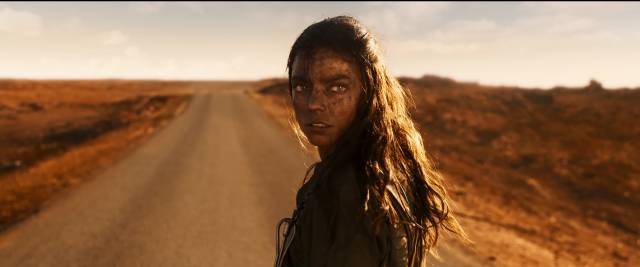
Furiosa: A Mad Max Saga (George Miller, 2024)
More satisfying, if not entirely successful, is Furiosa: A Mad Max Saga, George Miller’s fifth foray into cinema’s greatest post-apocalyptic future. While the series’ storytelling has an undeniable making-it-up-as-we-go-along quality, Miller’s approach to action and character gives the films a conceptual coherence which makes each new visit to that world exhilarating. Even in his late seventies, he remains unequalled as an action director and his world-building is so full of fascinating, unexpected details that these movies are visually inexhaustible.
That said, this side story is less well-formed than the previous films. As the title suggests, we’re in the world but not with Max himself – but then Max was essentially a supporting character in Fury Road. Charlize Theron’s Furiosa was Fury Road’s protagonist, and in the new film we get her origin story. This gives the narrative a sprawling quality which explores the world more widely but lacks the tight focus of the earlier films. As a child, Furiosa (Alyla Browne) lives among a matriarchal community in a fertile valley until an attack by marauders sees her captured by a tribe ruled by the violent warlord Dementus (Chris Hemsworth). He more or less adopts her and she grows up seeing terrible things before his attempt to trade with Immortan Joe (Lachy Hulme filling in for Hugh Keays-Byrne who died in 2020) gives her a chance to escape – you know life under Dementus is bad when Immortan Joe looks like a better choice.
Slightly implausibly, Furiosa manages to disguise herself as a boy when she reaches adolescence (barely escaping being raped) and grows to adulthood learning all the skills displayed by the character in Fury Road. Now played by Anya Taylor-Joy, convincingly suggesting a younger Charlize Theron, she becomes an important member of the community, fighting and driving in the wasteland where three separate communities uneasily coexist – Immortan Joe’s water-based oasis; Bullet Town, which manufactures and trades armaments; and Gastown, which pumps and refines the fuel everyone needs as they race around the desert. Dementus takes over the latter and his incompetence eventually leads to violent conflict among the communities.
There’s less action here than in Fury Road, but what there is displays Miller’s usual fine eye for densely-imagined detail – though there seems to be more CGI than in the previous movie, probably an inevitable development given the incredible risks involved in the complex stunts. Miller hasn’t lost his skill in conceiving epic action set-pieces, even if their execution has occasionally shifted from real bodies in real vehicles to the digital realm. And he certainly hasn’t lost any of his skill in creating distinctively quirky characters who surround the more traditionally heroic protagonist. While even the smallest roles are given distinctive identities, it’s the conception of Dementus which gives the film its most interesting quality. Rather than a dominant figure like the Humungous in The Road Warrior, Auntie Entity in Beyond Thunderdome or Immortan Joe himself in Fury Road, Dementus is a sadistic blow-hard with grandiose plans to be the wasteland’s dominant warlord, plans far beyond his capabilities. He’s incompetent, running Gastown into the ground through bad management and fomenting revolution among the oppressed workers producing the gasoline. It’s refreshing to see a post-apocalyptic warlord who isn’t in full command of his realm, a dolt who has attained power only because everything has collapsed and there was a space he was able to fill despite a lack of talent. Hemsworth provides one of the most entertaining elements in the entire Mad Max universe.
Miller is apparently in pre-production on another Mad Max movie, though where he might take the story from here (the end of Furiosa ties into the beginning of Fury Road) is anyone’s guess. The first three films were only loosely connected, the world depicted changing with each new episode, while the two more recent ones are more closely tied together, which may be more limiting for another sequel.
*
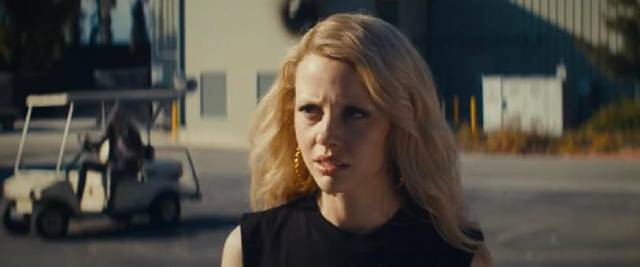
MaXXXine (Ti West, 2024)
A year after watching X and Pearl (both 2022) on disk, I saw Ti West’s conclusion to the trilogy he has made in close collaboration with Mia Goth. From the beginning of his career – he made The Roost (2005) in his mid-twenties – he’s played enthusiastically with genre tropes, frequently exploring and deconstructing rather than merely reiterating. Although he does at times revel in gore, his work generally has a stripped-down minimalist quality which adds a note of classicism to his style. He followed the overt horror of The Roost with Trigger Man (2007), a thriller so laconic in its depiction of some friends out for a day’s hunting in the Delaware woods that the viewer, having been lulled by the men’s easy, almost wordless interactions, is suddenly shocked to attention by the long-delayed eruption of violence when they suddenly become prey themselves, forced to fight for their lives.
This was followed by the unhappy experience of Cabin Fever 2, a job-for-hire sequel to Eli Roth’s debut feature which was taken away from West and cut by the producers, then shelved for a couple of years before being dumped to video. By the time it was finally released, West had gone back to making his own projects with the commercially and critically successful The House of the Devil (2009), followed by the old-fashioned ghost story The Innkeepers (2011), some television work and contributions to V/H/S and The ABCs of Death (both 2012). The Sacrament (2013) tackles a Jonestown-style religious cult and In the Valley of Violence (2016) is a fine western. Then from 2016 to 2020, West spent his time working on various TV series before connecting with Mia Goth, a fruitful partnership which has led to a multi-faceted exploration of filmmaking itself, with references to ’70s exploitation on the fringes, ’50s Technicolor melodrama, and now the cut-throat business of corporate Hollywood in the ’80s, with a sideline in the Right-wing fundamentalist religiosity of the Reagan years.
In X, Goth played Maxine Miller, a former child-preacher who escaped her father’s church and became a porn actress; she and a crew, having rented a cabin on a remote farm to shoot a movie, find themselves in the midst of a Texas Chainsaw-like slaughter. In Pearl, Goth plays the titular character, a small-town girl with dreams of stardom in the years after World War One, who gradually goes insane and becomes the killer whom Maxine and her friends run into decades later. West switches from the raw, unadorned style of ’70s horror to the lush colours and heightened emotions of ’50s studio polish with ease, and now in MaXXXine he captures the way studios appropriated the earlier raw style and polished it with higher budgets in the psycho/slasher movies of the ’80s.
Goth returns as Maxine, her surname changed to Minx, reflecting her status as a porn star. But she wants to go legit and pursues roles in the mainstream. West weaves a lot of threads into this familiar story (Goth’s Maxine echoes Naomi Watts’ Betty Elms in Mulholland Drive [2001], but without the innocence); there’s a woman director trying to prove herself in a male-dominated industry by infusing a B-movie horror sequel with some deeper, subversive themes; there’s a groundswell of Satanic panic raising the alarm about the dangers of pop culture and calling for censorship; there’s a serial killer targeting women in the city who seems to be homing in on Maxine and her acquaintances in the porn business; there are a couple of cops who think she knows something about the murders; there’s a sleazy private eye tracking her down for someone deep in her past. And all these things gradually come together in a bloody final act as her fundamentalist past catches up with her.
While West wraps up the story of Maxine with a sense of narrative inevitability, the film doesn’t present any conclusive ideas about the role of pop culture in a reactionary society – but perhaps it’s unfair to expect a movie like this to answer large questions which have haunted genre entertainment for as long as filmmakers have been exploiting sex and violence in their efforts to attract and satisfy their audience. What matters here is a well-told story which serves as a showcase for one of the most interesting actors currently working.
*
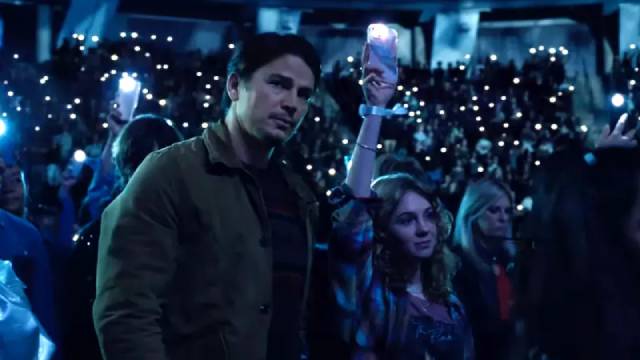
Trap (M. Night Shyamalan, 2024)
As usual, the knives were out in anticipation of the release of a new M. Night Shyamalan movie. I made a point of reading nothing ahead of time – I didn’t even watch the trailer – and went with friends to the first show of Trap on opening day without any idea what it was about. And, as usual, I thoroughly enjoyed it even if there are flaws (why are Shyamalan’s flaws so widely considered to be more egregious than anyone else’s?). I’m glad I didn’t have any foreknowledge as I got the full benefit of the movie’s gradual revelations about what was actually going on – revelations already given away by the trailer apparently.
It opens with dad Cooper (Josh Hartnett) arriving at an arena where he’s treating his daughter Riley (Ariel Donoghue) to a concert by her favourite performer, Lady Raven (Saleka Shyamalan). There’s an easy charm in their dad-daughter back-and-forth, but as they enter with the crowd, an obviously larger-than-normal police presence creates an undercurrent of unease. As the concert gets started, we become aware that the arena is now sealed by heavily armed SWAT teams who are supporting an FBI unit led by profiler Dr. Josephine Grant (the casting of Hayley Mills was a nice surprise) who is tracking a serial killer called the Butcher, whom they have reason to believe is at the concert.
No surprise at this point that Cooper is the man they’re looking for. While maintaining his dad role for Riley, who is focused on the performance on stage, Cooper has to calculate moment by moment how to evade the tightening dragnet, improvising (and harming arena staff) as he methodically devises an escape plan which makes use of his own unsuspecting daughter. His sociopathy creates a suspenseful how-to narrative which has a satisfying internal logic. It’s only in the final third of the movie, after he and Riley make it out of the law enforcement net, that Shyamalan’s plotting gets a bit rocky with a series of mini-climaxes and a string of seeming endings which lead to yet another tangent.
It’s during this stretch that Cooper seems to acquire almost superhuman skills which suggest that Trap is another piece in Shyamalan’s construction of his on-going superhero/supervillain mini-universe which began with Unbreakable (2000) and continued with Split (201y) and Glass (2019). This disrupts the taut, self-contained narrative to a degree, but not fatefully (for me, anyway). Personally, I think Trap is up there with his best work despite a few stumbles, with Hartnett and Donoghue both giving excellent performances, well-supported by the rest of the cast. The biggest potential pitfall would be building so much of the film around the concert and making that a showcase for the director’s daughter (who wrote and performed the songs) before she takes an active role as the protagonist in the third act. Yet Saleka Shyamalan acquits herself convincingly as a star adored by her teenage fans and handles the dramatic conflict with Cooper well.
Comments
I agree with your opinon of Trap. I also saw the movie “cold” and I enjoyed it quite a bit. I’d say it’s one of the director’s better movies for sure. I thought Josh Hartnett played his part perfectly as well. The concert was convincing and Saleka Shyamalan is a very good performer.